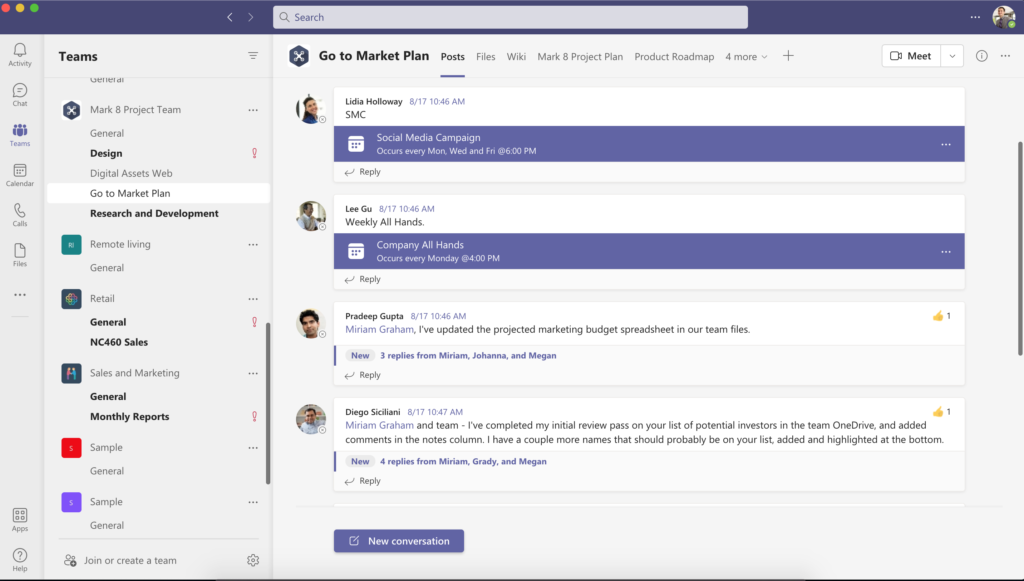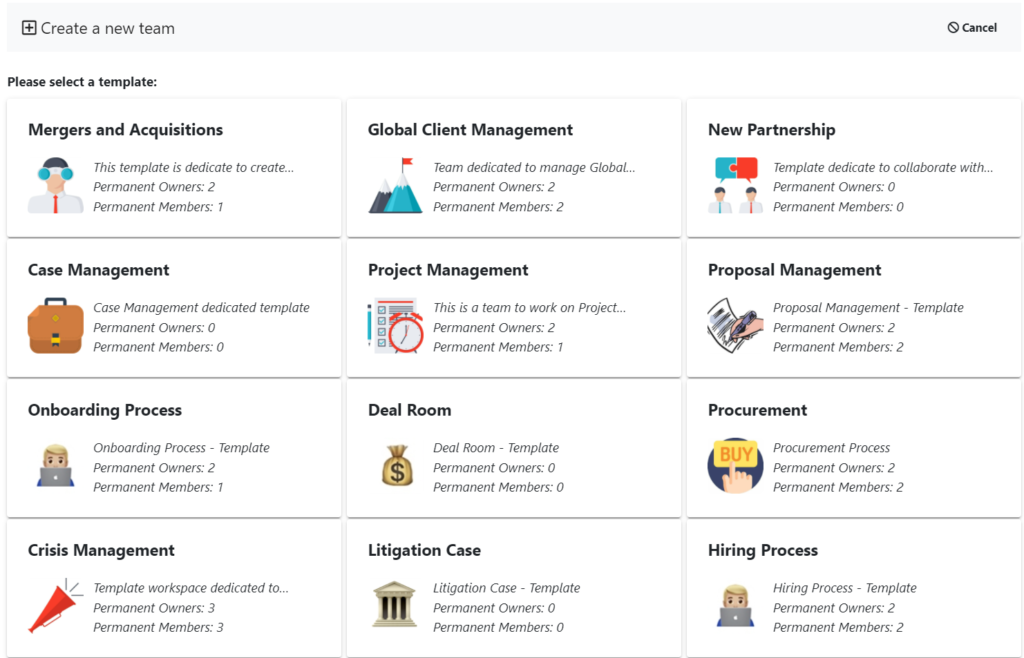Digital transformation has been one of the latest trends for businesses worldwide. It has many advantages that heavily reflect on employees’ productivity and efficiency. However, moving to the digital workspace is not enough without a revolutionary business plan. The real innovation lies behind revisioning business processes to become more agile and digitally compatible. This org-wide transformation must engage all the stakeholders: from top-level managers to employees, third party contractors, and even clients.
With its collaboration solution Microsoft Teams, Microsoft created the perfect hub for everything a business needs. It helps them to transform digitally and become better in terms of inner processes and structural relationships. It helps modernize the business processes rather than support the current ones with scruffy software. The business-oriented approach behind Microsoft Teams makes it a modernizing method rather than just an environment. Modernizing the processes requires inspiration and tools. While Microsoft Teams provides intelligent tools, you need to inspire your team to get used to it.
Here are four ways in which Microsoft Teams can help you modernize your business processes.
1. Enhanced communication
Whether a company is office-based, remote, or hybrid, achieving success requires a high level of communication. Communication is a must both internally among employees and externally with clients and service providers. Digital transformation with Microsoft Teams introduces new technology-based communication and fosters more interactions across the organization. The tools it provides are a dynamic engine to encourage employees and teams to participate in more conversations and engage in ongoing discussions.
Microsoft Teams brings all kinds of teams – hybrid, on-site, remote, asynchronous – together under a single umbrella. So, everyone can feel more involved and be on the same page with their teammates. The ability to actively attend online meetings, conferences, brainstorming sessions, and audio calls with translation assistance, combined with productivity tools like notes, file sharing, real-time editing, and others, removes the distances and barriers between team members.
With Microsoft Teams, you can start a one-to-one chat, a group conversation, a channel discussion with a dedicated group of employees, and announcements. Microsoft Teams becomes the solid infrastructure for modernizing a company’s communication system. Plus, it’s very user-friendly and so your team will get used to it very fast.

2. Making data-driven decisions
Nowadays, being proactive is a competitive advantage. It benefits any business because it allows decision-makers to act quickly before others do. However, decision-making is not that easy. Especially with big organizations where a single decision could cause a disaster if wrongly analyzed or made too late. Making the right decision requires collecting and smartly analyzing corresponding data, then transferring it to a visual form so that all stakeholders can understand. This process could sometimes be time-consuming, and by the time everything is ready, something could change, and the data becomes useless.
Data-driven decision-making requires a fast and intelligent solution to collect the information from various sources, cross-check it, analyze it, then convert it into a visual form. Microsoft Teams does it all in real-time using an AI approach to teach the system how to enhance the analyzing process and become better over time.
“Business users can quickly self-serve the datasets they need and build their own reports. They feel in complete control because they own and invest in it.” Srinivas Kanamarlapudi, senior software engineer on the Data Intelligence team at Microsoft
Power BI and Microsoft Teams
Using the concept of datasets, Teams allows users to create their own dashboards to track their personalized indicators in real-time and act accordingly. You can do all of these through Power BI which is a tool that unifies data from many sources and creates visualized reports that provide actionable data-driven insights. Here is how you can use Power BI.
Go to the team where you want to employ Power BI, select Apps and search Power BI.
The homepage is full of information, so you can read the introductions and explore the app a bit. Once you’re done, select Add. To generate a report, click on the + New report button.
As you can see, you can either manually enter data or analyze your Teams data. When you paste your data into Power BI, it will generate a visualized report for you that may look something like this:
With such comprehensive visualized data reports, decision making becomes much easier and certainly more effective.
Also, if you’re curious about how your employees work on Microsoft Teams, you can select the third option – Analyze your Teams data. It will present you with an overview of your team’s activity including chats, meeting summaries, number of participants, etc.
Learn more about Power BI here.
Microsoft Teams is not just a communication platform or a file-sharing hub, but an intelligent center of information. It helps search, collect, analyze, and visualize data then learn from previous experiments to bring better results the following times.
3. Access to third-party and native solutions
When employees can access all the applications and information from a single platform, it saves lots of time that is otherwise wasted on juggling between apps. This issue might not seem serious at first glance but looking deeper into it uncovers a dilemma. Specifically, for communication applications, workers today are using an average of four apps, with 20% of workers using six or more. This includes apps for phone calls, texts, web meetings, video conferencing, team messaging, and more. 69% of workers waste up to an hour each day navigating between myriad communications apps, amounting to a waste of 32 days per year.
Microsoft Teams integrates with many other applications to form a single platform employees need to us. And instead of jumping from one app to another, they can access everything from the Teams interface. The Teams developer platform allows professionals to create integrations with Microsoft Teams, so Teams users can access some of their favorite 3rd party service providers. This capability makes the digital transformation process a lot easier for companies. For instance, if a company uses dedicated accounting and booking software, like QuickBooks, or a project management software like Trello. All these apps can be easily integrated with Microsoft Teams to enable team communication and other features while accessing Quickbooks database or tracking the progress of ongoing projects in Trello with a single click inside Teams.
4. Achieving operational excellence
Operational excellence is all about optimizing your business processes to stay ahead of your competitors. By using Microsoft Teams, you not only modernize but also optimize your processes which leads to achieving operational excellence.
When you bring everyone involved in the collaboration process under the same roof and provide them with a medium where they can talk, discuss, and exchange information in a structured and organized manner, you optimize one big and extremely critical business process – communication.
When you make informed decisions based on the best available data, you significantly reduce the chances of having to redo something or deal with its harsh consequences. This is textbook optimization of a business process.
And lastly, when you automate your business processes by integrating apps and tools in one platform, you reduce admin work. Just like that, by introducing and using a single platform you tackle three issues at once. And at the end of the day, pave the way for operational excellence.
You can learn more about operational excellence and how to achieve it here.
Microsoft Teams in action
All of these sounds amazing on paper but how does it really work in real life? Well, you’ll need to try Microsoft Teams for yourself and see. But in the meantime, we can go over an example derived from real life to understand how Microsoft Teams will modernize your business processes.
DLW is a web development agency that builds websites and mobile apps. It has four different teams of programmers, and each has their own project manager. They also have an in-house sales team, design team and the finances are outsourced to an accounting firm.
After the pandemic, the whole company has adopted a hybrid working model.
To organize and facilitate their day-to-day work, the company introduces Microsoft Teams. Each department gets their team where they can create dedicated channels for more focused conversations. Besides, they also have a general team where they share company-wide updates and of course, trending TikToks.

Let’s make a quick stop at the sales team to see how they’re organizing their work. As you can see from the screenshot below, they have individual channels for prospective clients, service updates, proposals, tenders. This way their whole communication is structured and easily accessible.
In the proposal channel, you will see that they have Files pinned to their tab bars. In Files, they have folders for archived, ongoing and to be submitted proposals and other documents that come in handy. They also have Adobe Sign pinned to their tabs, which they use to sign the finalized proposals.

Improving business processes with a template solution
So, what happens when the sales team acquires a new client? They can send out an email to the project manager of the team that will be working on the new project. Or they can create a new team in Microsoft Teams for their new account. The sales team representative creates a team and depending on their working style, he or she will add the client, the project manager, developers’ team lead and the design team lead. This new team becomes a workspace that brings together all these stakeholders. Here they can chat, share updates, hold calls, and even sign contracts.
As you can see, communication and workflows in this company are structured and optimized but they can take it to a whole new level. How? By integrating a template solution. Suppose DLW is a large company and the sales team acquires a lot of clients on a monthly basis. Creating a dedicated team for all of them can become a hassle. A template solution helps eliminate this and do the work once. The sales team creates a template with all the necessary structure for one client and then when the others come along, they simply replicate it and voila, there is a new team for each new account.

If you use Collaboration Templates by nBold, you can benefit from even more capabilities such as copied files and folders, integrated and pre-configured everyday tools, added permanent members (e.g., the lawyer who puts together the contracts), naming rules, security settings, and more. This way you can optimize the entire process even further.
Final thoughts
Microsoft Teams was designed to modernize business structures by encouraging communication, fostering collaboration, and enhancing everyone’s work experience. It increases productivity and helps reach a higher level of agility within an organization. Microsoft Teams deploys AI-based solutions to help stakeholders make their decisions wisely and manage their businesses more efficiently and smartly. It’s a digital environment that would boost businesses to a better future. Start using it today and you will see the results.
